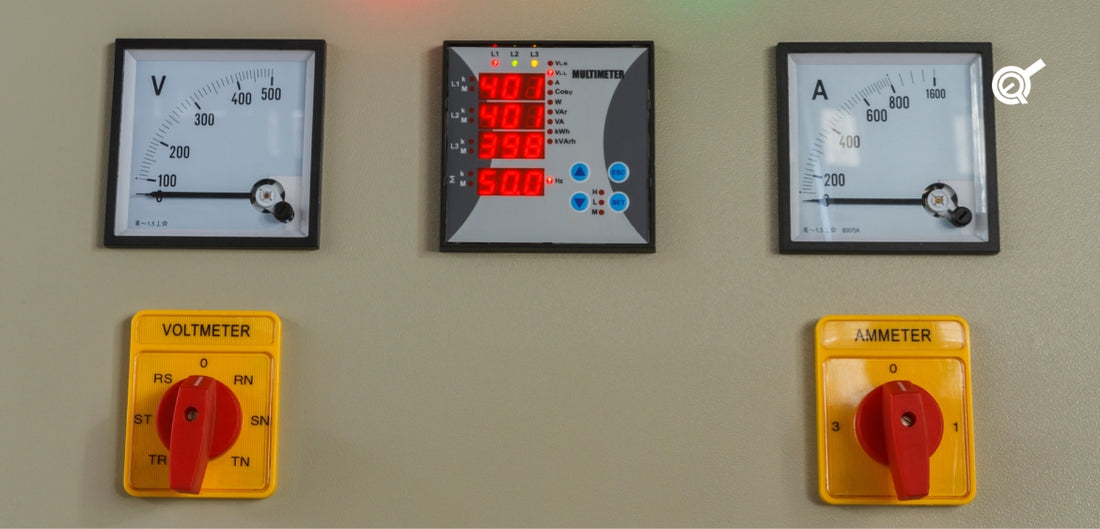The electrical industry has many different terms used to describe the ratings and requirements of electronic devices. For example, you may have seen a power supply label with a current rating of "20 A", an output voltage of "12 VDC", and a description indicating "240 W" in watts. Understanding the meaning behind these types of ratings is especially crucial to ensure proper operation and meet electrical safety requirements when integrating actuators together with other electrical components. In this article, we will cover the difference between amps, volts, and watts for working with electric linear actuators.
Understanding Amps: Current Flow Measurement

In the electrical industry, current represents the volume flow of electrons and uses amperes (A) or "amps" for short as the unit of measurement. The electrical current expressed in amperes refers to how many coulombs of electrons were flowing through a circuit’s path per second.
1 coulomb ≈ 6,241,509,074,460,762,607 electrons
1 coulomb ≈ 6.24 × 10^18 electrons
1 A ≈ 1 coulomb/ second
Therefore:
1 A ≈ 6.24 × 10^18 electrons/ sec
Another analogy to visualize the flow of electricity through wires is like imagining water flowing through pipes. Instead of the electrons per second found in amps (A), water flowing through pipes can be measured with units such as liters per second (l/s).
Defining Volts: Electrical Potential Difference

Volts (V) is the unit of measurement for voltage which represents the electrical potential difference between two points in a circuit. This potential difference is what can allow for the capability to do work such as illuminating a light bulb or cycling a linear actuator back and forth. Depending on whether an actuator was AC or DC, you may find their voltage listed as "VAC" or "VDC".
J = The unit of energy known as "joule"
Voltage = Potential energy/ electrons
Therefore:
1 V = 1 J/ 1 coulomb
Another analogy to visualize the electrical potential difference between the (+) positive and (-) negative terminals of a battery is like imagining a water pump causing a difference in water pressure. Instead of chemical processes inside a battery causing the potential for electrons to flow from one terminal to the other, water pumps have the potential to draw water inwards on one side and push water through the output hose.
The Meaning of Ohms: Electrical Resistance

In the electrical industry, an ohm (Ω) is a unit used for measuring the electrical resistance of a load inside a given circuit. Any component that opposes or slows down electrical current flow in a circuit can be considered a load and will cause some electrical resistance.
Resistance (Ω) = ρ ℓ/ A
Where:
ρ = a material’s electrical resistivity measured in ohm-meters (Ω·m)
ℓ = wire length in meters (m)
A = wire’s cross-sectional area (m^2)
Another analogy to visualize electrical resistance is like imagining water flowing through pipes of varying sizes. Replacing thin wires with thicker wires for reducing electrical resistance is like replacing narrow pipes with wider pipes so that water can flow with less restriction. Also, longer wires cause more electrical resistance just like how longer pipes results in more restrictive water flow from the greater energy transfer loss.
Uncovering Watts: Power Calculation

Watts (W) is a unit used for measuring electrical power which can be calculated by multiplying voltage (V) and electrical current (I). Measuring both the voltage and current using two measuring instruments at the same time allows a user to get the necessary parameters for calculating the power consumption of the watts being drawn by an actuator at a given moment. This is to determine the amount of work done over a period of time (joules per second). The relationships between power, current, and voltage can be found in Watt's Law as seen below:
P = V × I
Power = Voltage × Current
1 W = (1 V) × (1 A)
1 W = (1 J/ 1 coulomb) × (1 coulomb/ second)
1 W = 1 J/ second
Another analogy to visualize electrical power is like imagining flowing water generating power by falling from a certain height and landing on a water wheel. Instead of the flow of electricity causing work to be done by a DC motor, the flow of falling water causes rotational motion from a water wheel which can be used for grinding grain into flour.
Calculating and Measuring Electrical Parameters

The relationships between voltage, current, and resistance can be found in Ohm's Law, where:
Voltage = Current × Resistance
V = I × R
I = V/ R
R = V/ I
In certain conditions, these formulas can also be used in combination with those found in Watt’s Law for analyzing a circuit and becomes very helpful when calculating for a missing variable or parameter. This may sometimes be due to the limitations in what variables can be safely or conveniently measured. These formulas are also useful in case a measuring instrument can measure certain variables with greater accuracy than others.

Multimeters are perhaps the most common measuring instrument found in the electrical field due to their overall versatility and capability of measuring most of the electrical parameters we need. Since multimeters can come with different features, range settings, and port setup requirements, it is important to correctly configure your multimeter according to the user manual and manufacturer recommendations before taking a measurement.

Having a DMM (Digital Multi-Meter) inline to a circuit allows for more direct contact, resulting in greater accuracy and precise current draw readings. Clamp meters are not ideal for sudden rise or fall of current and will generally be less accurate compared to a digital multimeter, however, they become helpful measuring instruments in certain conditions. Clamp meters are more convenient since they easily clamp around wires while a DMM requires the user to break their circuit to place their DMM inline to measure current. If the current flow is continuous, clamp meters can also be used for trying to figure out if an electric actuator is binding or faulty.
Using Amps, Volts, and Watts in Practical Applications
Now that we have the basics covered, we can apply this knowledge in how we choose the components we will be using with actuators. When choosing a power supply and/or control box, we need to make sure these devices are models that will output the same voltage value as the operating voltage of our chosen actuator. We also need to verify that the actuator we will use has a current draw that is less than or equal to what the power supply and/or control box was rated to handle.
If you want to replace a power supply or controller for a DC actuator that has a missing label (or no information), measure the voltage drop between its two terminals using a multimeter. Then, verify how many amps the motor draws when fully loaded. This will help give a better understanding of the actuator’s electrical power consumption and what ratings to look for if you need to replace the other electrical components which will be wired with the actuator.
IN SUMMARY
Knowledge of the different electrical terms used in the industry is crucial for understanding which power source, controller, and/or actuator will have the suitable ratings to match each other’s electrical safety requirements. It also becomes useful for figuring out the general ratings, limitations, and compatibility of other components found inside electrical systems and appliances.
We hope you found this as informative and interesting as we did, especially if you were curious to know more about the difference between amps, volts, and watts when using actuators! If you have any queries or wish to discuss our products further, please do not hesitate in reaching out to us! We are experts in what we do and will be happy to assist in any way we can.
sales@progressiveautomations.com | 1-800-676-6123




